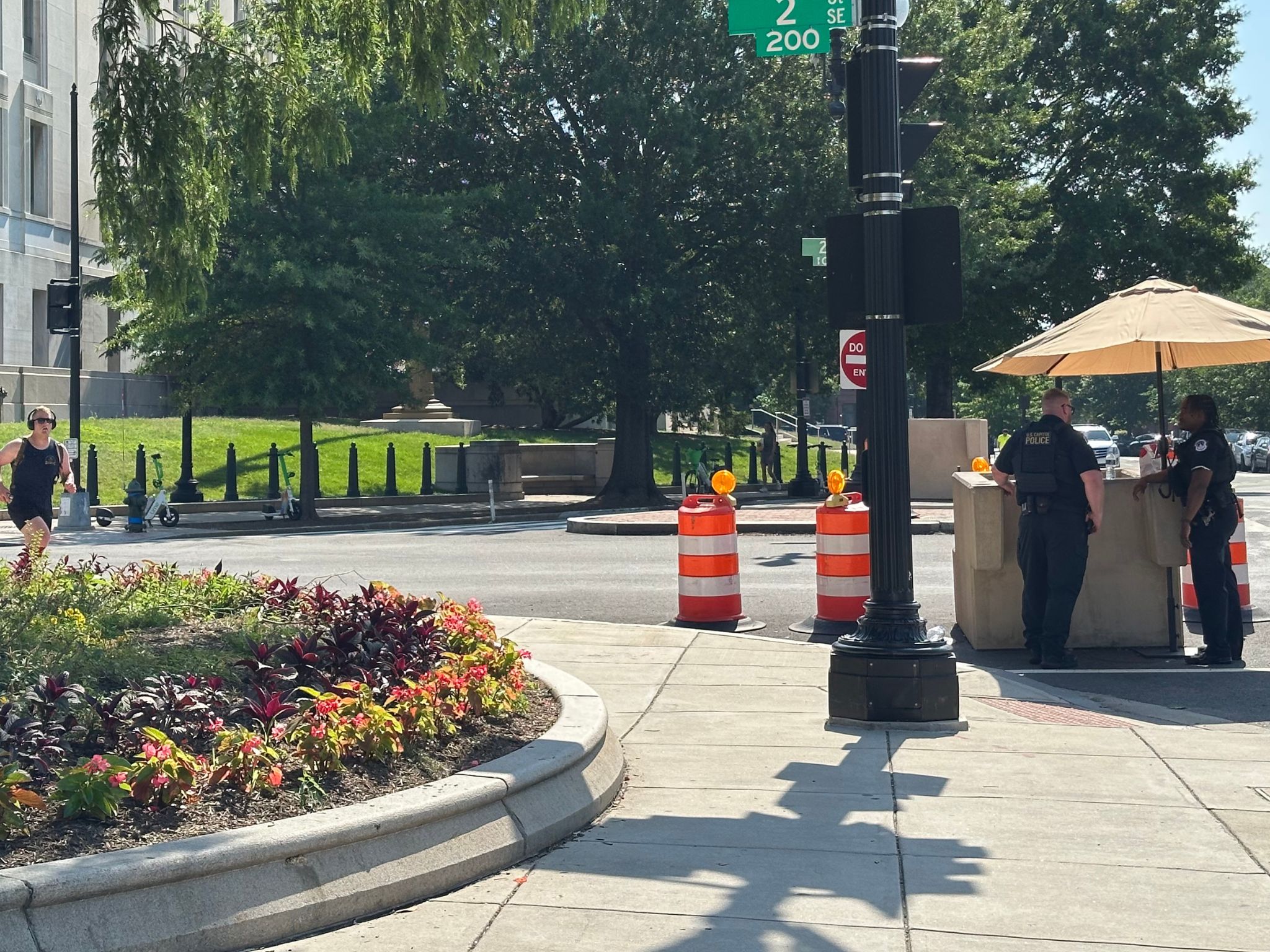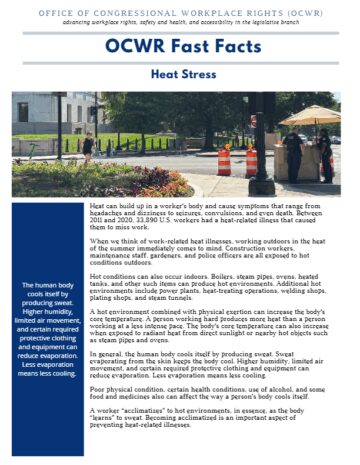Heat can build up in a worker’s body and cause symptoms that range from headaches and dizziness to seizures, convulsions, and even death. Between 2011 and 2020, 33,890 U.S. workers had a heat-related illness that caused them to miss work.
When we think of work-related heat illnesses, working outdoors in the heat of the summer immediately comes to mind. Construction workers, maintenance staff, gardeners, and police officers are all exposed to hot conditions outdoors.
Hot conditions can also occur indoors. Boilers, steam pipes, ovens, heated tanks, and other such items can produce hot environments. Additional hot environments include power plants, heat-treating operations, welding shops, plating shops, and steam tunnels.
A hot environment combined with physical exertion can increase the body’s core temperature. A person working hard produces more heat than a person working at a less intense pace. The body’s core temperature can also increase when exposed to radiant heat from direct sunlight or nearby hot objects such as steam pipes and ovens.
In general, the human body cools itself by producing sweat. Sweat evaporating from the skin keeps the body cool. Higher humidity, limited air movement, and certain required protective clothing and equipment can reduce evaporation. Less evaporation means less cooling.
Poor physical condition, certain health conditions, use of alcohol, and some food and medicines also can affect the way a person’s body cools itself.
A worker “acclimatizes” to hot environments, in essence, as the body “learns” to sweat. Becoming acclimatized is an important aspect of preventing heat-related illnesses.
The following chart describes different illnesses that can result from heat stress, including their related symptoms and first aid methods recommended by the Occupational Safety and Health Administration and the National Institute for Occupational Safety and Health. In the event of an emergency, please seek attention from a medical professional.
Seek medical attention if you or your coworkers experience any of the following symptoms:
| Condition | Symptoms | Remedy/Prevention |
| Heat Stroke | Distinct absence of sweating, hot red or flushed dry skin, dizziness, headache, nausea, vomiting, confusion, bizarre behavior, high body temperature, convulsions, and loss of consciousness. | Call 911 immediately. Move the victim to a cool, shaded area. Soak the victim’s clothing with cool water. Apply cold packs on the neck, armpits, and groin, and fan vigorously. |
| Heat Syncope | Dizziness, light-headedness, nausea, weakness, headache, and fainting. | Sit or lie down, elevate legs, and hydrate. Monitor the victim’s vital signs (breathing, pulse, and temperature), and seek medical attention if symptoms worsen. |
| Heat Exhaustion | Heavy sweating, intense thirst, headache, dizziness, nausea, fatigue, loss of coordination, impaired judgement, hyperventilation, tingling in hands or feet, cool moist skin, and a weak and rapid pulse. | Allow the victim to rest in a cool place and rehydrate. Apply cold packs as needed. Severe cases may require medical supervision. |
| Heat Cramps | Painful muscle spasms, usually affecting the arms, legs, or stomach. | Drink water or an electrolyte beverage, gently stretch the affected muscles. |
| Heat Rash | Red pimples or blisters appearing on the neck, upper chest, groin, or elbow creases. | Keep the skin dry, apply a cool compress if needed. |
Heat Illness Prevention
Measures to prevent heat illness include environmental monitoring, engineering controls, worker acclimatization, frequent water intake, work practices, training, and medical screening.
Monitoring the environment through various methods and responding appropriately can prevent heat stress in outdoor settings. One commonly used environmental measurement tool is the WetBulb Globe Temperature (WBGT). The WBGT measures the potential heat stress hazard in direct sunlight. It accounts for ambient temperature, air movement, humidity, and radiant heat load. These measurements can provide guidance for scheduling breaks in cool areas and ensuring the body has sufficient time to cool down and recover. Another widely used measurement is the heat index (apparent temperature). The heat index does not account for air movement, radiant heat, or other factors, such as the effects of personal protective equipment.
Engineering control measures can prevent heat stress by providing cool and/or dry air to awork area. Examples include: air conditioning to cool the air; portable blowers, including those that provide a mist to directly cool the area where workers are located; and insulation and shields to reduce heat radiating from hot surfaces. Engineering changes are usually the most reliable means for preventing heat-related illnesses.
Acclimatization occurs by gradually increasing the body’s exposure to heat over time. New employees and workers returning from an absence of two weeks or more should have a 5-day period of acclimatization. This period should begin with 50 percent of the normal workload and exposure time on the first day, gradually building up to 100 percent on the fifth day.
Frequent intake of liquids is necessary to prevent dehydration through loss of sweat. Plenty of cool (50°F–60°F) water or other cool liquids (except beverages with alcohol or high caffeine levels) should be available. Encourage workers to drink small amounts frequently. Although some commercial replacement drinks contain salt and other electrolytes, these types of liquids are not usually necessary, and can exacerbate medical conditions such as hypertension.
Work practices must be implemented to prevent heat from building up within the body and to allow the body to cool down. Such practices include:
- Reducing the physical demands of work;
- Providing air-conditioned enclosures and rooms for recovery;
- Scheduling work for the cool part of the day or at night;
- Using intermittent rest periods with water breaks;
- Using relief workers and reduced work practices; and
- Work-rest cycles, where workers rest for a set period in a cool area so their bodies don’t become overheated. Rest times are generally based on the WBGT, discussed above.
Additional work practices, such as a “buddy system,” are needed when cool areas are unavailable for employee rest breaks. In a buddy system, workers are designated to observe each other for signs of heat stress. Some signs of heat stress, such as bizarre behavior, can best be observed by another person. A buddy system should be employed in each remote area where maintenance work is done.
Another useful practice is self-monitoring. Workers can self-monitor by regularly tracking their pulse rates. Exposure to heat should be ceased if the employee’s sustained pulse rate exceeds 180 beats per minute, minus the employee’s age. For example, a 40-year-old person should not have a pulse rate greater than 140 beats per minute when working in hot environments. Recovery heart rate, taken 1 minute after rest begins, should not exceed 110 beats per minute.
Workers can also self-monitor by weighing themselves before and after exposure to hot environments. A risk of dehydration exists if the weight lost through sweat exceeds 1.5% of the worker’s body weight.
Training is vital for workers to recognize the effects of heat and how to avoid them. Workers should understand the following subjects:
- hazards of heat stress;
- environmental factors that affect heat stress;
- predisposing factors, danger signs, and symptoms;
- first aid procedures for heat stroke;
- signs of heat stroke, dehydration, and heat exhaustion;
- work practices used in the employers’ hot environment protection program;
- importance of fluid intake and acclimatizing;
- use of protective equipment such as ice vests or reflective clothing, if applicable;
- environmental monitoring tools employed; and
- medical screening programs.
Medical screening should identify illnesses, drug use, and other risk factors that might predispose a worker to the risk of heat stroke.

